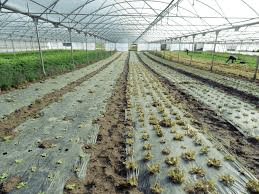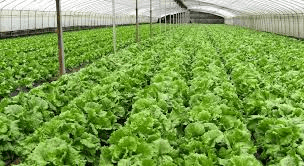Organic agriculture techniques are methods used to grow crops and raise livestock without synthetic chemicals, such as pesticides, herbicides, and fertilizers. These techniques aim to promote ecological balance, conserve biodiversity, and sustain soil health.
One fundamental technique in organic agriculture is crop rotation. This practice involves growing different types of crops in the same area in sequenced seasons. Crop rotation helps manage soil fertility and reduce soil erosion. It also prevents the build-up of pests and diseases that can occur when one species is continuously cultivated. For example, planting legumes can naturally replenish nitrogen in the soil, benefiting the subsequent crops.
Another crucial technique is the use of cover crops. Cover crops, such as clover and rye, are planted during off-seasons when the soil might otherwise be left bare. These crops prevent soil erosion, improve soil structure, and add organic matter to the soil when they decompose. They can also suppress weeds and manage soil moisture.
Composting is a vital organic agriculture technique. Composting involves recycling organic matter, such as kitchen scraps and yard waste, into a rich soil amendment. This process enriches the soil with nutrients and beneficial microorganisms, enhancing its structure and fertility. Composting helps reduce the need for chemical fertilizers and promotes healthy plant growth.
The practice of green manure is another important organic technique. Green manure refers to plants that are grown specifically to be incorporated back into the soil. These plants, often legumes, are plowed under while they are still green to enhance soil fertility and organic matter content. This practice not only provides nutrients but also improves soil structure and water retention.
Organic farmers also employ natural pest management strategies. This includes the use of beneficial insects, such as ladybugs and predatory wasps, to control pest populations. Crop diversity and rotation can disrupt pest cycles, making it harder for pests to establish and proliferate. Farmers may also use physical barriers, such as row covers, to protect crops from pests.
Soil health is maintained through techniques like minimal tillage. Tillage involves preparing the soil for planting, but excessive tillage can lead to soil erosion and degradation. By minimizing tillage, organic farmers preserve soil structure, enhance water infiltration, and protect soil microorganisms that contribute to soil fertility.
Mulching is another technique used in organic agriculture. Mulch, such as straw or wood chips, is spread over the soil surface to conserve moisture, suppress weeds, and regulate soil temperature. As mulch decomposes, it adds organic matter to the soil, further enriching it.
Water management is also a key aspect of organic farming. Techniques such as drip irrigation and rainwater harvesting ensure efficient water use and minimize water waste. Proper water management practices help maintain soil health and ensure that crops receive adequate moisture without over-reliance on external water sources.
Organic agriculture techniques extend to livestock management as well. Animals are raised in conditions that allow for natural behaviors and access to the outdoors. They are fed organic feed, and the use of antibiotics and synthetic hormones is avoided. Manure from livestock is composted and used as a natural fertilizer, contributing to a closed-loop system.
Lastly, biodiversity is a cornerstone of organic farming. Diverse plantings and the maintenance of natural habitats around farms support a variety of beneficial organisms. This biodiversity enhances ecosystem resilience and productivity, making farms more sustainable and less dependent on external inputs.
Organic agriculture techniques focus on creating a harmonious relationship between farming practices and the natural environment. Through crop rotation, cover cropping, composting, green manure, natural pest management, minimal tillage, mulching, water management, and biodiversity, organic farming aims to produce healthy food while preserving the health of the ecosystem.
Key Organic Agriculture Techniques

1. Crop Rotation: Alternating the types of crops grown in a particular area from season to season to prevent soil depletion, reduce pest and disease pressure, and improve soil fertility.
2. Cover Cropping: Planting cover crops such as legumes, clover, or rye during off-seasons to protect and improve soil health by adding organic matter, enhancing nitrogen levels, and preventing erosion.
3. Composting: Using decomposed organic matter, such as kitchen scraps, yard waste, and manure, to enrich soil with nutrients and beneficial microbes, improving soil structure and fertility.
4. Green Manuring: Growing specific plants (green manures) that are later incorporated into the soil to improve its organic content and nutrient levels.
5. Integrated Pest Management (IPM): A holistic approach to pest control that combines biological, mechanical, and cultural methods to manage pest populations in an environmentally friendly way.
6. Organic Fertilizers: Using natural substances like compost, manure, bone meal, and fish emulsion to provide essential nutrients to plants, improving soil health and fertility without synthetic chemicals.
7. Mulching: Applying organic materials such as straw, leaves, or wood chips to the soil surface to retain moisture, suppress weeds, and add nutrients as they decompose.
8. Minimal Tillage: Reducing soil disturbance by avoiding or minimizing tillage, which helps preserve soil structure, organic matter, and beneficial soil organisms.
9. Water Conservation: Implementing efficient irrigation systems such as drip or soaker hoses to conserve water and provide consistent moisture to plants.
10. Polyculture and Companion Planting: Growing multiple plant species together to enhance biodiversity, support beneficial insects, and reduce pest and disease incidence.
Applications of Organic Agriculture Techniques
1. Vegetable Gardens: Organic techniques are widely used to grow vegetables in home and commercial gardens, ensuring nutrient-rich, chemical-free produce.
2. Fruit Orchards: Techniques like crop rotation, composting, and mulching are applied to maintain soil health and support healthy fruit production.
3. Grain and Legume Farming: Organic methods are used to grow grains and legumes, enhancing soil fertility and reducing reliance on synthetic inputs.
4. Livestock Farming: Organic principles are applied to raise livestock, focusing on natural feed, rotational grazing, and humane treatment.
5. Landscapes and Public Spaces: Organic techniques improve soil health and sustainability in parks, gardens, and other public landscapes.
Read Also: Pigs Breeding Cycle and Recommended Practices
Composting and Mulching Techniques

1. Composting
Benefits: Composting transforms organic waste into nutrient-rich soil amendments that improve soil fertility, structure, and microbial activity. It also reduces the need for chemical fertilizers.
Techniques:
i. Traditional Composting: Layering green (nitrogen-rich) and brown (carbon-rich) materials, maintaining moisture and aeration, and turning the pile regularly to speed up decomposition.
ii. Vermicomposting: Using worms, particularly red wigglers, to decompose organic waste. This method is efficient for small-scale operations and produces high-quality compost (vermicast).
iii.Bokashi Composting: An anaerobic fermentation process using a mix of microorganisms to decompose organic waste quickly, suitable for kitchen scraps and small-scale composting.
2. Mulching
Benefits: Mulching conserves soil moisture, suppresses weeds, regulates soil temperature, and adds organic matter as it decomposes.
Techniques:
i. Organic Mulches: Using straw, leaves, grass clippings, and wood chips to cover soil. These materials gradually break down, enriching the soil.
ii. Living Mulches: Planting cover crops like clover or vetch that grow alongside main crops, protecting the soil and adding nutrients when turned under.
iii. Sheet Mulching: Layering cardboard or newspaper with organic matter on top to smother weeds and improve soil health over time.
Water Conservation Strategies
1. Efficient Irrigation Systems
Benefits: Reducing water usage while maintaining crop health is crucial for sustainable farming, particularly in areas facing water scarcity.
Techniques:
i. Drip Irrigation: Delivers water directly to plant roots through a network of tubes and emitters, minimizing evaporation and runoff.
ii. Soaker Hoses: Porous hoses laid on the ground that slowly release water along their length, effectively watering plants with minimal waste.
iii. Rainwater Harvesting: Collecting and storing rainwater for irrigation, reducing reliance on groundwater and municipal water supplies.
2. Soil Moisture Management
Benefits: Enhancing soil’s water-holding capacity reduces the need for frequent irrigation and improves plant resilience during dry periods.
Techniques:
i. Organic Matter Addition: Incorporating compost and mulch into the soil increases its ability to retain moisture.
ii. Cover Cropping: Planting cover crops during off-seasons to protect soil from erosion and improve its water-holding capacity.
iii. Contour Farming: Planting along the natural contours of the land to slow water runoff and encourage infiltration.
Organic Livestock Management
1. Animal Welfare
Benefits: Ensuring high standards of animal welfare aligns with organic principles and can improve livestock health and productivity.
Techniques:
i. Pasture-Based Systems: Allowing animals to graze on organic pastures, providing them with a natural diet and environment.
ii. Rotational Grazing: Moving livestock between pastures to prevent overgrazing, reduce parasite load, and promote pasture regrowth.
iii. Free-Range Systems: Giving animals access to the outdoors, ensuring they have space to express natural behaviors.
2. Organic Feed and Healthcare
Benefits: Providing animals with organic feed and natural healthcare methods ensures they remain healthy without the use of synthetic substances.
Techniques:
i. Organic Feed: Using organically grown feed free from GMOs, synthetic pesticides, and fertilizers.
ii. Natural Remedies: Implementing herbal treatments, homeopathy, and probiotics to manage animal health and prevent diseases.
iii. Stress Reduction: Minimizing stress through humane handling practices, proper housing, and environmental enrichment.
Weed Management Without Chemicals
1. Cultural Practices
Benefits: Reducing weed pressure naturally promotes healthier crops and reduces reliance on chemical herbicides.
Techniques:
i. Crop Rotation: Rotating crops to disrupt weed life cycles and reduce the weed seed bank in the soil.
ii. Cover Cropping: Planting cover crops to outcompete weeds, suppressing their growth through shading and allelopathy.
iii. Intercropping: Growing multiple crop species together to cover soil and reduce weed establishment.
2. Mechanical and Manual Methods
Benefits: Physical removal of weeds can be effective and environmentally friendly.
Techniques:
i. Hand Weeding: Manually removing weeds, suitable for small-scale operations or high-value crops.
ii. Hoeing: Using hoes to cut weeds at the soil surface, effective for larger areas and row crops.
iii. Mulching: Applying organic mulches to smother weeds and prevent their emergence.
3. Biological Control
Benefits: Using natural predators or competitive plants to manage weed populations is a sustainable alternative to chemicals.
Techniques:
i. Introducing Beneficial Insects: Using insects that feed on weed seeds or foliage to reduce weed populations.
ii. Allelopathic Plants: Growing plants that release chemicals inhibiting weed growth, such as rye or sorghum.
Read Also: Guide to Proper Management of Piglets
Frequently Asked Questions (FAQs) About Organic Agriculture Techniques

1. What are organic agriculture techniques?
Organic agriculture techniques are methods used to grow crops and raise livestock without synthetic chemicals, focusing on natural and sustainable practices to enhance soil health, biodiversity, and environmental sustainability.
2. How do organic agriculture techniques differ from conventional farming methods?
Organic techniques avoid synthetic pesticides and fertilizers, relying on natural methods like composting, crop rotation, and biological pest control to maintain soil fertility and manage pests.
3. What are the main benefits of using organic agriculture techniques?
Benefits include improved soil health, reduced chemical exposure, enhanced nutrient quality in produce, increased biodiversity, and support for sustainable farming practices.
4. How does crop rotation benefit organic farming?
Crop rotation prevents soil depletion, reduces pest and disease pressure, and improves soil fertility by alternating crops that have different nutrient requirements and growth patterns.
5. What is composting, and why is it important for organic farming?
Composting involves decomposing organic matter like kitchen scraps and yard waste to create nutrient-rich compost. It enhances soil fertility, structure, and microbial activity, essential for healthy plant growth.
6. What is integrated pest management (IPM), and how does it work?
IPM is a holistic approach to pest control that combines biological, mechanical, and cultural methods to manage pest populations sustainably. It aims to minimize environmental impact and reduce reliance on chemical pesticides.
7. How do organic fertilizers differ from synthetic fertilizers?
Organic fertilizers are derived from natural sources and release nutrients slowly, improving soil health over time. Synthetic fertilizers are chemically produced and provide nutrients quickly but can lead to soil degradation and environmental issues.
8. What are cover crops, and how do they benefit organic soil?
Cover crops are plants grown to improve soil health by adding organic matter, enhancing nitrogen levels, and preventing erosion. They are typically tilled back into the soil to decompose.
9. Can organic agriculture techniques be used for large-scale farming?
Yes, organic agriculture techniques can be effectively used for large-scale farming. Many commercial farms successfully implement these methods to produce organic crops and livestock.
10. How can I get started with organic agriculture techniques?
Start by improving soil health through composting, selecting appropriate organic fertilizers, practicing crop rotation, and integrating pest management strategies. Educate yourself on specific techniques and gradually implement them based on your farming or gardening goals.
Read Also: How to Write an Essay

